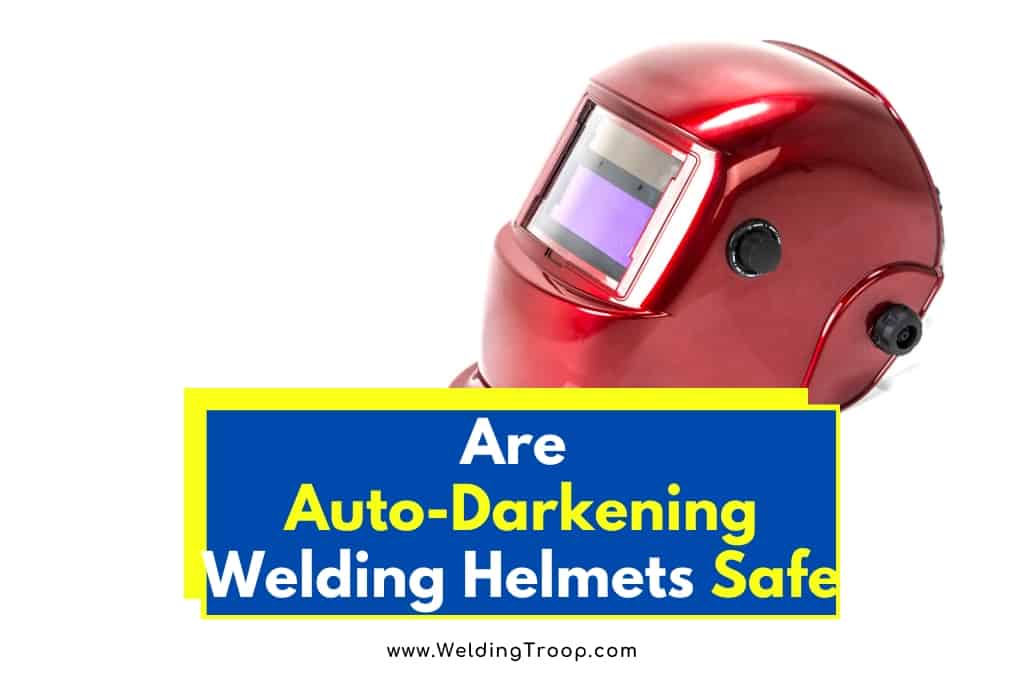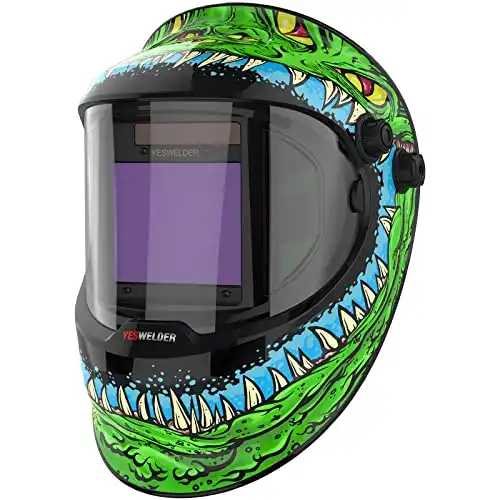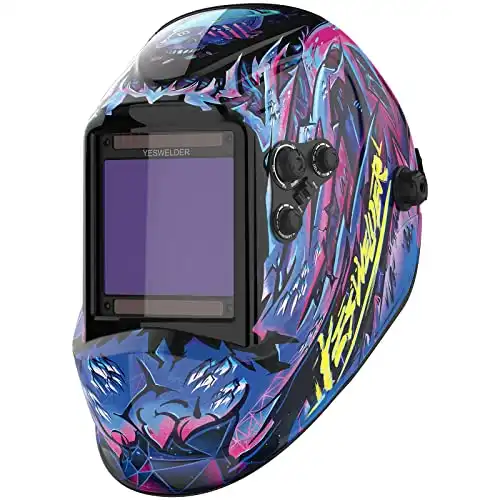Protecting a welder’s eyes is important because of the risk of arc eye and retina burns, which are painful and can lead to loss of vision. Welding helmets protect a welder’s eyes, face, and neck. Auto-darkening welding helmets seem like a great solution, but you may be concerned about their safety.
Are auto-darkening welding helmets safe? Yes. When used properly, auto-darkening welding helmets are safe, if not safer than passive welding helmets. Auto-darkening helmets do not have to be taken on and off, helping welder’s focus on their projects and reduce the risk of errors and injuries.
Welders have a variety of choices when choosing a welding helmet. Safety, style, function, and budget all play a role. When deciding whether to buy an auto-darkening helmet, it is important to understand how the helmets work and the pros and cons of such a helmet.
Table of Contents
Why is a Welding Helmet Necessary?
Arc Welding processes such as mig welding, plasma cutting, stick welding, and tig welding emit harmful ultra-violet ways that, just like the sun, are harmful to the human eye. Protecting your eyes and face from these ultraviolet and infrared rays, and gasses and splashes emitted during welding is a high priority.
Arc eye, a common hazard for welders, is the burning of the back of the retina caused by exposure to the ultra-violet rays emitted during welding. Arc eye is painful and can lead to temporary or permanent blindness and can increase the likelihood of eye cancer.
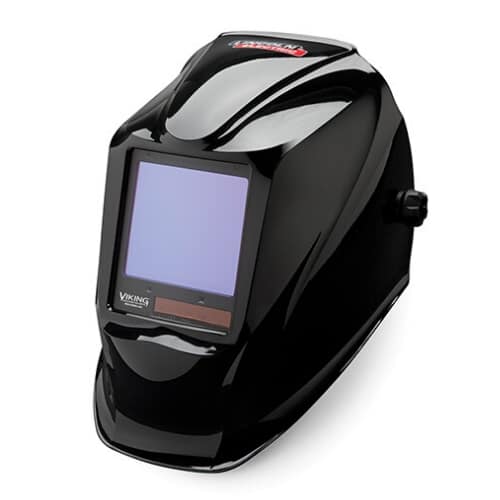
Wearing a helmet with a darkened lens is how welders can see what they are doing without damaging their eyes.
Around the world, there are safety standards with which helmet manufacturers should comply. In the United States, the industry standard for welding helmets is promulgated by the American National Standards Institute (ANSI) Z87.1. This organization establishes criteria for the use and testing of helmets.
These standards are not mandatory, so when buying a helmet, you should confirm that it is ANSI (or the equivalent in your home country) compliant.
How Do Auto-Darkening Helmets Work?
Auto-darkening lenses, as the name suggests, automatically adjust from light to dark when light emission is detected. A combination of filters and cells in the viewing pane block out ultraviolet and infrared light when sensors detect light.
- An ultraviolet and infrared interference filter blocks high levels of ultraviolet and infrared radiation at all times, even when the auto-darkening lens is not activated.
- A polarization filter, when used with the ultraviolet and infrared filter darkens the light.
- Liquid crystal cells are what make the lens automatically darken and lighten based on the intensity of the light.
- Sensors in the helmet detect when an arc is struck. The light from the arc triggers the sensors, which transmit a signal that activates the liquid crystals and darkens the mask to the pre-determined fixed shade level.
- Auto-darkening helmets are powered by battery power, solar power, or a combination of both types of power.
Auto-darkening helmets are safe when used properly, but you must make sure they are in working order and set to the right settings for your job. User error and failure to check that the helmet is working are the main reasons an auto-darkening welding helmet would not be safe.
Related Reading: How to Adjust an Auto Darkening Welding Helmet: A Quick Guide
Auto-Darkening Welding Helmet vs. Passive
Auto-darkening helmets were not invented until the early 1980s. Before auto-darkening helmets, welders wore (and still often wear) passive welder helmets.
Passive welder helmets have one dark lens shade. Passive helmets must be manually taken on and off while welding because the welder cannot see out of it except while welding.
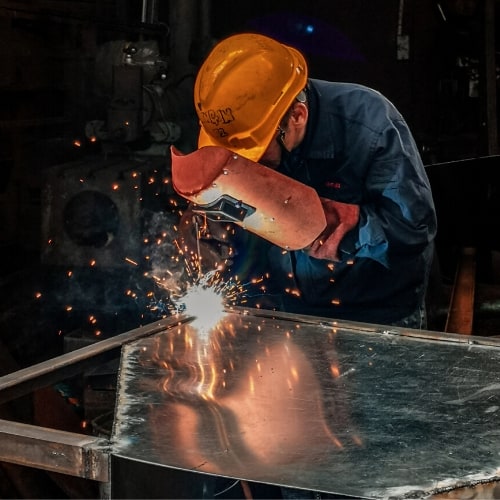
When deciding which type of helmet to invest in, it may help to understand the pros and cons of each type of helmet.
Auto-Darkening Helmets
| Pros | Cons |
|---|---|
| Auto-Darkening Feature. The lens starts out light and then becomes dark so the welder can see the project clearly without removing the helmet. This allows for fewer disruptions during the project. | Affordability. Auto-darkening helmets are often more expensive than passive helmets because of the technology in the helmet. The sensors, batteries, and liquid cell technology are expensive. |
| Visibility. The welder does not need to flip the helmet up and down during the project, which minimizes the chances of an arc flash or other injury. Constant visibility also speeds up the project. | Batteries. Many auto-darkening helmets are battery-powered. A welder must make sure the helmet is charged or bring along replacement batters to ensure there is no loss of power during a job. |
| Maneuverability. A welder can work in tight spaces without having to flip the helmet up and down, which may make the job easier to complete. | Heaviness. Auto-darkening helmets are heavier than passive helmets because of the extra parts. This can cause discomfort to the head and neck during long projects. |
| Constant Protection. The lens in an auto-darkening helmet protects against ultraviolet and infrared rays even when the lens is not darkened. | Repairs and Replacements. Repairs and replacements of parts are more expensive, and the welder may have to outsource the repairs if they are too complicated. |
Passive Helmets
| Pros | Cons |
|---|---|
| Affordability. Passive welding helmets are more affordable than auto-darkening welding helmets. Different lenses can be purchased for a variety of different projects at a low cost. | Visibility. The welder cannot see with the helmet on unless in the process of welding. |
| Lightweight. Passive helmets are lighter than auto-darkening helmets because they do not have sensors, batteries, and other extra parts. This helps prevent fatigue during a job. | Versatility. If a welder does not buy a variety of shades, a passive helmet will restrict the types of work a welder can perform. The helmet usually only comes with one lens and different welding jobs require different types of shades. |
| Size. Passive helmets are often smaller, allowing for a better fit in tight welding spaces. | Disruption. A passive helmet must be taken on and off during the welding process because the welder cannot see the project through the helmet when the arc is not on. |
| Repairs and Replacements. With fewer parts that can break, replacing parts is cheaper and easier. | Misplacement. Taking the helmet on and off during welding may cause incorrect placement of the helmet or bad timing in lowering the helmet, which can lead to arc flashes. |
| Operation. A welder does not have to learn about adjusting controls or worry about changing batteries. |
Choosing the right helmet depends on your budget and the type of welding projects that you do.
While passive helmets are more affordable and easier to repair, auto-darkening helmets allow for more consistent welding work because the helmet does not have to be flipped on and off during a project.
Many welders opt for the auto-darkening helmets because of the ability to leave them on during the project. This allows for jobs to be completed more quickly and safely.
Considerations When Purchasing an Auto-Darkening Welding Helmet
Not all auto-darkening welding helmets are created equal. The size, shape, weight, and other features play a role in choosing the right helmet for your needs. Before buying a helmet, consider these criteria:
- Safety Standards. Helmets should comply with nationally recognized safety standards.
- In the United States, the industry standard for welding helmets is ANSI Z87.1. These standards are not mandatory for manufacturers to follow, so you will have to check the packaging to see if it complies.
- The Occupational Safety and Health Administration (OSHA) sets out requirements for welding helmets in the workplace. If you hire welders for your business, you will need to make sure the helmets comply with OSHA standards.
- Light Sensitivity Settings. Light sensitivity settings determine how much light it takes to activate the auto-darkening filter. Some models have these settings on the outside and others on the inside. The standard settings may be good for your needs but knowing how to adjust these settings is important to ensure you have the best protection for your project.
- Viewing Area. Helmets have different sized viewing panels. For a wider peripheral vision, select a larger viewing area. The size of the viewing area is a personal decision based on a welder’s need, but be sure to consider it when purchasing a helmet.
Related reading: Welding Helmets With Cheater Lens and Their Maintenance
- Arc Sensors. Arc sensors protect a welder from getting flashed. An auto-darkening welding helmet comes with 2-4 sensors. The number of sensors you need will depend on the project. Two sensors are fine for environments with few obstructions. If you work in small spaces or at odd angles you should have three or four sensors to make sure there is at least one sensor that is not blocked.

- Reaction Time and Delay. The delay feature allows a welder to shorten or lengthen the duration of the darkening depending on the welding project. For fast-moving welding projects like tack welding, a shorter duration allows welders to move swiftly.
- Power Source. Auto-darkening helmets can be battery-powered or solar-powered, or a combination of each. Some helmets have a non-replaceable lithium battery. Helmets with these non-replaceable batteries last about seven years. If you have a helmet with a replaceable battery carrying spare batteries is a good idea.
Related Reading: How to Charge a Solar Welding Helmet?
- Variable vs. Fixed Shades. Some auto-darkening helmets are fixed-shade, meaning, like passive helmets, they only darken to one shade (usually a 10). Other -auto-darkening helmets have variable shades built-in that are adjustable based on the project. Most variable shade lenses adjust from shade 9 through 13. A variable shade is more convenient when working on a project that requires different shades.
- Weight. Auto-darkening helmets vary in weight up to a pound. That may not seem like a lot, but it is noticeable at the end of the day. Looking for a lightweight helmet will help ease neck strain and delay fatigue.
- Comfort. An auto-darkening welding helmet should be comfortable and easy to adjust. You will be working with the helmet for hours at a time, so comfort is critical. Most helmets today have comfort in mind with features like padded straps and pads. Trying a helmet on is the only way to gauge comfort.
- Warranty. The warranty on a helmet is usually between two and five years. Check the packaging and instructions for details about the warranty. This is not the most important factor in choosing an auto-darkening welding helmet, but it is a consideration.
Auto-Darkening Helmet Care and Maintenance
It is important to take care of your welding helmet. Maintaining your helmet helps ensure that it works properly to protect your eyes and face. A good welding helmet will last you several years. Here are steps you can take make sure your helmet is working properly.
- Check the Lens. The lens is the most important part of a welding helmet. It is what protects a welder from harmful ultraviolet and infrared rays. Inspect the lens regularly to confirm there are no cracks and that the lens is clean. If you notice the lens is damaged, it should be replaced.
- Test the Helmet. There are several ways to test the auto-darkening mechanism on the mask. There are a few methods used to test the helmet:

- A torch strike can be used to test your auto-darkening welding helmet. With your helmet on, strike the torch in front of your view. The spark should cause your helmet to darken.
- Glancing at the sun with your mask on will help confirm that all the welding helmet features are working. When you glance at the sun, the lens should darken. Then move your hand in front of your face (to mimic what you do when you weld) to ensure that the lens still registers the light and remains dark.
Related reading: Can You Look at the Sun or Eclipse with a Welding Helmet? Is It Dangerous?
- Using a television remote control that produces an infrared signal, you can point the remote control at your helmet and press the button on the remote. If your helmet is working properly, your helmet should switch to dark mode.
- Some people use an arc test to see if the helmet is working. This method is dangerous and not recommended. If your helmet is not working, you can damage your eyes by looking at the arc for just a few seconds.
- Test the Sensors and Knobs. Before each use, make sure that the helmet is working before beginning your project. Make sure sensors and knobs are tightened and set to the proper settings.
- Keep it Clean. Welding helmets should be cleaned often with a soft cloth. Avoid harsh cleaning chemicals. Sensors and solar cells should be cleaned with soap and water and dried with a clean, lint-free cloth. The helmet should not be submerged into water or any other liquid.
- Storage. Welding helmets should be stored in a clean and dry location. The temperature for storage should be moderate. Storing an auto-darkening welding helmet in extreme cold or heat can cause damage to the helmet. Exposing a welding helmet to dirt, water, and other elements can damage the lens or other components and cause helmets to wear out quicker.
Related reading: How to Properly Clean a Welding Helmet Lens – Fast and Easy
- Charge. Make sure your helmet is properly charged so that you can use it. If your helmet does not turn off automatically, check that it is off after each project. Check the batteries often to ensure they are still good. If your helmet uses replaceable batters, keep backup batteries with you.
Are Solar-Powered Auto-Darkening Welding Helmets a Good Choice?
Solar-powered helmets are a great option because they work off both solar-power and battery power. Having the option to use solar power helps save the life of the battery, which can be more economical in the long run. Solar-powered helmets are also often lighter, making them more comfortable for welders who wear the helmet all day.
Solar-Powered Helmets Can be Used Inside and Outside.
A common misconception about solar-powered welding helmets is that you must be working outside in the sun for the solar panel to charge. Solar panels in welding helmets can be powered by the sun, but they are also powered by the ultraviolet light from the arc
The battery power is used when the mask is first turned on. Once the welder starts welding, the solar panel gets power from the arc, and the solar panel powers the electronic components of the helmet. This saves the battery life.
How to Detect and Treat Arc Eye.
If a welding helmet is used correctly, it should prevent arc eye, also known as a flash burn. Knowing how to detect arc eye is important because accidents do happen.
Arc eye is like a sunburn on the eye. For welders, it occurs when the eyes are exposed to ultraviolet light from a welding torch. Often arc eye can heal on its own in a couple of days, but in some cases it cannot, and this can lead to serious and permanent injuries including loss of vision.
Related reading: Can Welding Really Cause Sunburn? Effect On Skin and Eyes
Symptoms of Arc Eye.
If you are working on a project and experience any of the following symptoms, it could mean you have arc eye:
- Pain in the eyes starting shortly after the incident
- Light sensitivity
- Watery or bloodshot eyes
- Blurred vision
- A feeling that something is stuck in your eye.
Treatment for Arc Eye.
If arc eye does not resolve in a day or two, there are treatment options, which may include:
- Resting the Eye. Dilating, wearing an eye patch, or both will help relax the eye muscles and help the eyes to rest and heal.
- Antibiotics. Arc eye can lead to an infection in the eye. Antibiotics may be prescribed by your doctor to stop the infection.
Auto-darkening helmets are a great advancement for welders. They allow a welder to work without constantly having to lift the helmet on and off, which allows welders to work more quickly and safely. These helmets are safe if they are well maintained and used properly. Choosing the best helmet depends on the welder’s needs and preferences.
Auto-Darkening Welding Helmet DEMO >> Check out the video below
Here are some of my favorite tools & equipment´s
Thank you for reading this article. I hope it helps you find the most recent and accurate information for your welding project. Here are some tools that I use daily and hope you´ll also find helpful.
There are affiliate links, so if you do decide to use any of them, I´ll earn a small commission. But in all honesty, these are the exact tools that I use and recommend to everyone, even my own family. (NO CRAP)
To see all my of most up-to-date recommendations, check out this resource that I made for you!

